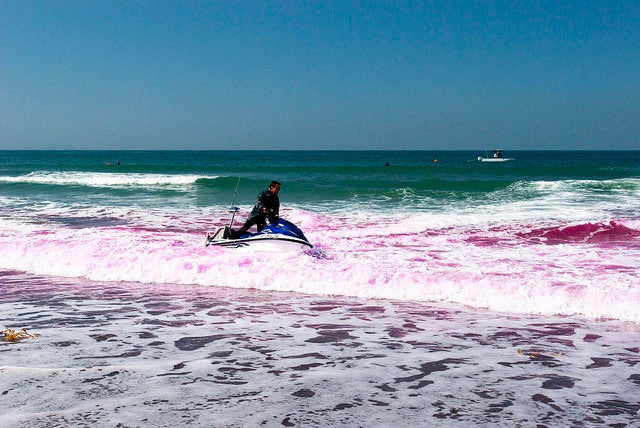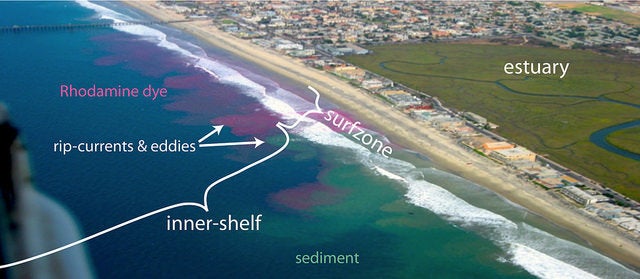What happens to all the trash and chemicals washed into the ocean after heavy rains? A team of U.S. and Mexican scientists are trying to find out by dyeing the ocean bright pink.
From Sept. 22 to Oct. 17, researchers with the University of California, San Diego's, Scripps Institution of Oceanography and Jacobs School of Engineering, along with several Mexican institutions, will release non-toxic pink fluorescent dye into beach waters in Southern California and Tijuana, Mexico.
During the experiment, known as the Cross Surfzone/Inner-shelf Dye Exchange project, or CSIDE, researchers track the dye's movement and dilution as it mimics the movements of pollutants that may affect human health and coastal ecosystems.

Researchers use a fluorometer, a device that measures dye fluorescence, to track the pink dye from the beach, boats and a Jet Ski. They also monitor the dye from an airplane, using a hyperspectral sensor that takes detailed measurements of the ocean's color.
During the first phase of the experiment on Sept. 23, researchers released 30 gallons of dye in the 8.5-mile stretch of water between Imperial Beach and Coronado in Southern California. Falk Fedderson, the project lead, said he was surprised with the results.
"We thought it would rocket in a plume up the surf zone, up the coast," Fedderson told the San Diego Reader. "It did that for a while, but then the dye just went offshore, and then it decided it wanted to go to Mexico. It basically did a U-turn."

CSIDE's results will be a model that can be applied to beaches around the world. Policy makers and coastal managers will be able to use CSIDE's research to make informed decisions when closing beaches due to heavy runoff from rain or sewage spills.
“This work applies broadly to coastlines around the world and has local relevance to the water quality problems experienced in the San Diego Bight,” Sarah Giddings, co-leader for the project, said in a press release. "We have developed a binational team of scientists because coastal water quality is not a national issue. Water currents, waves, and watersheds do not follow borders and thus neither do the things carried by the water."
The pink dye stays bright for six hours after it's released and is visible for up to 24 hours, according to Southern California Public Radio. Researchers will track the dye for up to 36 hours. The dye will be released at least twice more as part of the experiment.
"We're doing it for a variety of reasons, but I think one of the big reasons is to try to understand how and where and when our beaches are contaminated," Giddings told Southern California Public Radio.
Also on HuffPost:

